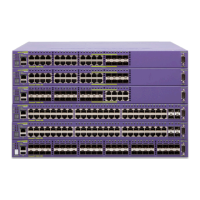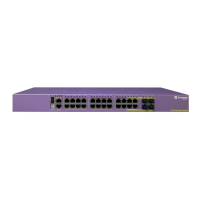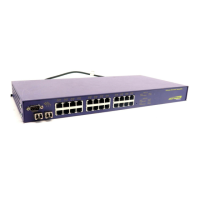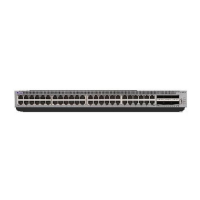82 Summit 200 Series Switch Installation and User Guide
Configuring Ports on a Switch
The following rules apply to the Summit 200 series switch:
• Ports on the switch must be of the same port type. For example, if you use 100 Mbps ports, all ports
on the switch must be 100 Mbps ports.
• Ports on the switch are divided into a maximum of six groups.
• Port-based and round-robin load sharing algorithms do not apply.
To define a load-sharing group, you assign a group of ports to a single, logical port number. To enable
or disable a load-sharing group, use the following commands:
enable sharing <port> grouping <portlist> {address-based}
disable sharing <port>
Load-Sharing Example
This section provides an example of how to define load-sharing on a Summit 200 series switch.
Load-Sharing on a Summit 200 Series Switch
The following example defines a load-sharing group that contains ports 9 through 12, and uses the first
port in the group as the master logical port 9:
enable sharing 9 grouping 9-12
In this example, logical port 9 represents physical ports 9 through 12.
When using load sharing, you should always reference the master logical port of the load-sharing group
(port 9 in the previous example) when configuring or viewing VLANs. VLANs configured to use other
ports in the load-sharing group will have those ports deleted from the VLAN when load sharing
becomes enabled.
NOTE
Do not disable a port that is part of a load-sharing group. Disabling the port prevents it from forwarding
traffic, but still allows the link to initialize. As a result, a partner switch does not receive a valid indication
that the port is not in a forwarding state, and the partner switch will continue to forward packets.
Verifying the Load-Sharing Configuration
The screen output resulting from the show ports configuration command lists the ports that are
involved in load sharing and the master logical port identity.
Switch Port-Mirroring
Port-mirroring configures the switch to copy all traffic associated with one or more ports. The monitor
port can be connected to a network analyzer or RMON probe for packet analysis. The system uses a
traffic filter that copies a group of traffic to the monitor port.
The traffic filter is defined by the physical port, meaning that all data that traverses the port, regardless
of VLAN configuration, is copied to the monitor port.
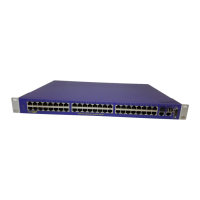
